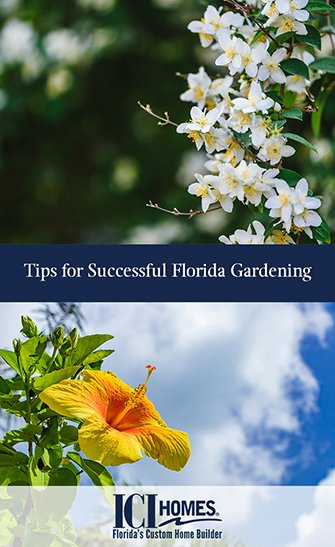The lure of lush Florida gardening is a big draw for many new residents to the sunshine state, especially those who hail from colder climates. If you’re used to only a few weeks or months of blooms, you’ll be thrilled to enjoy them year-round here.
But, there are differences to gardening in semi-tropical and tropical climates,  and we at ICI Homes are offering some timely — and hopefully helpful — tips for a successful Florida gardening experience.
and we at ICI Homes are offering some timely — and hopefully helpful — tips for a successful Florida gardening experience.
Read more to get the scoop.
Trade old favorites for new ones
While Florida gardening is (almost) effortless, the Sunshine State won’t be hospitable to some annuals, perennials, trees and shrubs that thrive in colder climates.
For example, don’t expect to successfully transplant peonies, bulbs like tulips that need cold winters to bloom in the spring, and other such things. Your odds might be better in north Florida, which gets a bit more chill than central and south Florida, but be aware that coaxing cool-weather plants in Florida likely will result in a frustrating experiment.
Instead, do some preliminary research before you move into your new custom Florida home. Scan websites and visit local nurseries, if possible, to pick some new bloomers that resemble your favorites. You’ll set yourself up for happy surprises and avoid wasting time, money and energy.
Embrace the heat and sunshine
Ask your ICI Homes sales associate or builder ahead of time for the landscaping plan for your new custom Florida home. The foundation plantings will be good fits for the local climate, and are an easy jumping-off point to learning about what grows well here.
As another example, you’ll see southeastern U.S. stalwarts like azaleas (spring) and crape myrtles (summer into fall) in public and private landscaping. Tropical classics include hibiscus shrubs, bird of paradise plants and — of course — as many palm varieties as you can imagine.
Better yet, check out the U. S. Department of Agriculture’s plant hardiness zones. From north to south, respectively, Florida’s zones are 8, 9, 10 and 11. Knowing what USDA zone you’ll garden in helps you choose healthy plants that love the Sunshine State as much as you do.
Make new Florida gardening friends
Folks who work at local nurseries are great resources. Ask about plants for full sun, partial sun and shade (which can be different than the same conditions in other climates).
Neighbors often are happy to help, and there might be a gardening group in your new neighborhood — a great way to meet those neighbors.
Ready for your new custom Florida home? Talk to ICI Homes here.








